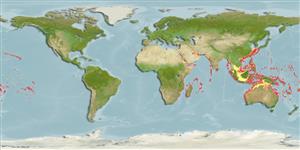Classificação / Names
Common names from other countries
Referência principal
Tamanho / Peso / Idade
Max length : 39.0 cm TL macho/indeterminado; (Ref. 9710); common length : 20.0 cm TL macho/indeterminado; (Ref. 3322)
Ambiente
; marinhas associadas(os) a recifes; intervalo de profundidade 3 - 150 m (Ref. 9824)
Clima / Intervalo
Tropical, preferred 27°C (Ref. 107945); 32°N - 35°S, 26°E - 138°W
Distribuição
Indo-Pacific: throughout the Indian Ocean, including the Red Sea and the Persian Gulf to Hawaiian, Marquesas, and Society islands, north to southern Japan, south to Lord Howe Island. Record from the eastern Mediterranean incorrect (Ref. 9824).
Países | Áreas FAO | Ecossistemas | Ocorrências | Introduções
Descrição breve
Espinhos dorsais (total): 0; Raios dorsais moles (total): 84-97; Espinhos anais 0; Raios anais moles: 61 - 73. Eyed side with dark spots, blotches and rings on body and median fins; 1 distinct dark blotch on middle of straight section of lateral line; narrow dark crossbars on eyed side of pectorals (Ref. 4417). Pectoral rays 9-12 (eyed side) and 9-11 (blind side).
Categoria na Lista Vermelha da IUCN (Ref. 115185)
Ameaça para o homem
Harmless
Utilização humana
Pescarias: espécies comerciais
Mais informação
ReferênciasAquaculturaPerfil para aquaculturaEstirpesGenéticaFrequência dos alelosHereditariedadeDoençasProcessamentoMass conversion
Ferramentas
Relatórios especiais
Descarregue XML
Fontes da internet
Estimates of some properties based on models
Phylogenetic diversity index
PD50 = 0.5000 many relatives (e.g. carps) 0.5 - 2.0 few relatives (e.g. lungfishes)
Nível Trófico
3.5 ±0.37 se; Based on food items.
Resiliência
Baixo, tempo mínimo de duplicação da população 4,5 - 14 anos (Preliminary K or Fecundity.)
Vulnerabilidade
Moderate to high vulnerability (48 of 100)
Categoria de preço
